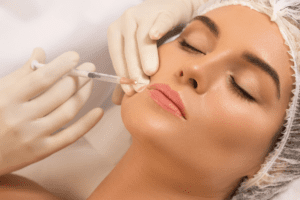
Ashley Piercing: Embrace Edgy Elegance with this Unique Lips Beauty Tips

Ashley Piercing: Embrace Edgy Elegance with this Unique Lips Beauty Tips
Overview of Ashley Piercing
The Ashley piercing is a unique lip piercing. It involves puncturing the lower lip and passing a long, straight barbell through it. This piercing isn’t suitable for all anatomy or skill levels. A numbing agent is used before inserting the jewelry.
The Ashley piercing is not only aesthetically appealing, but it can also provide added stimulation during kissing or sexual activities. It takes 8-12 weeks to heal fully. To prevent infection, regular cleaning and aftercare is needed.
If you are considering an Ashley piercing, choose an experienced piercer with proper sterilization techniques and high-quality jewelry. Be aware of potential risks, such as infections and jewelry migration.
Ready to express yourself? Consult with a professional piercer today to find out if the Ashley piercing is right for you!
Procedure
Jewelry is a diverse array of ornaments such as necklaces, earrings, and rings. It is crafted using materials like gold, silver, and gemstones.
Jewelry can be used for special events like weddings and parties, or just to complete your daily look.
It must be cared for to retain its shine and lasting quality. This includes proper storage, cleaning techniques, and avoiding exposure to harsh chemicals.
Jewelry has long been seen as a symbol of wealth and status. Plus, its craftsmanship dates back centuries!
So, show off your style with jewelry and make sure to maintain it. Enjoy the elegance it brings to your look!
Managing pain and healing during recovery is important as medical procedures can be uncomfortable. Pain management may involve medication, heat therapy, massage, or relaxation exercises. Recovery time differs according to the operation type and site. Minor surgeries can take a few days to heal, while major surgeries may take weeks or months.
In addition to pain management, incision care, proper nutrition, and physical therapy are key for a successful healing process. It’s essential that patients attend follow-up appointments with the doctor for proper monitoring of the healing.
Opioids have traditionally been used for pain management, but they bring the risk of addiction and respiratory depression. Nowadays, multimodal approaches with opioids and alternatives like NSAIDs can reduce side effects while managing pain.
Knowing about pain management and the healing process can help patients manage their expectations before and after surgery, leading to better results. And remember, if at first you don’t succeed with the procedure, skydiving is always an option!
Risks and Safety
Wash handswith soap and water or use alcohol-based hand sanitizer regularly to avoid infections. Also, cover mouth and nose while coughing or sneezing with tissue paper or elbow joints.
Don’t share personal items like towels, utensils, combs, etc. Infections can bring severe health issues like fever, coughs, skin rashes and stomach troubles.
Children, elderly and people with weakened immune systems face higher risks. For better protection against infections, be sure to sanitize high-touch areas like doorknobs, light switches and desks in addition to hand hygiene measures.
Denial of acceptance and relocation can bring safety worries. Displacement can lead to problems like financial issues, joblessness, bad healthcare, and even more crime. It can also create tension and sadness. Therefore, it is essential to take caution when handling rejection and movement, to avoid further damage.
Brushing teeth is like putting on a seatbelt – a small step that can stop a lot of hurt in the future.
Aftercare
To properly care for your Ashley piercing, effective aftercare is necessary with focus on cleaning and maintenance, as well as following precautions while eating and drinking.
By thoroughly understanding the benefits of proper aftercare and following these sub-sections diligently, you can ensure quick and successful healing of your Ashley piercing.
Cleaning and Maintenance routines are important to prevent dirt and other substances from damaging machines. This increases their lifespan and ensures smooth operation.
It’s important to note that different machines require different maintenance procedures. For example, electric motors need to be checked for rust and other foreign objects by trained professionals.
To ensure optimal performance, implement daily upkeep checklists for workers and take immediate action to address any issues. This reduces downtime and business losses. Regular cleaning is also necessary to comply with health and safety regulations.
After treatment, adequate hydration is key. Drink water, coconut water, fruit juices, and warm herbal tea. Avoid acidic foods and drinks such as sodas, alcohol, coffee, or spicy foods for 24-48 hours post-surgery.
Focus on soft, easy-to-digest foods like smoothies, soups, and mashed potatoes. To help promote healing and reduce inflammation, have smaller meals throughout the day. Avoid heavy snacks close to bedtime; have a light dinner two hours before sleep.
Drink lukewarm fluids during mealtimes. Use heat therapy to help with bowel function if constipated or bloated. Fiber-rich fruits, such as bananas or peaches, help keep bowels healthy and prevent pain around the surgical site. Maintenance is key to sustain recovery!
Cost and Sustainability
- Initial cost: $50-100
- Jewelry Replacement Cost: $20-50
- Healing Time: 6-8 weeks.
- Aftercare Products: $5-10.
- Longevity: Several years with proper care.
High-quality, biocompatible jewelry is essential. Cleaning the piercing daily with saline solution and avoiding contact will help it heal quickly and prevent bacterial infection. Active folks should wear protective gear while playing sports or engaging in physical activities to avoid trauma that may cause complications.
Top Tips
- Regular cleaning boosts Ashley piercing's lifespan. If you're looking for bold yet practical, this is it!
Conclusion
The Ashley piercing is a unique and pretty oral piercing. It needs a skilled piercer to do it right. With the correct aftercare, it can heal well and look great. Before getting it done, consider the risks and maintenance required.
When looking for an Ashley piercing, find an experienced piercer with a good track record. Cleaning and eating carefully are musts during the healing period. Tiny studs or small hoops are usually used, but there can still be migration or rejection risks.
Everyone’s body is different, so the Ashley piercing may not work for everyone. Future dental work could also mean the piercing can’t be kept.
An Ashley piercee shared their story. After trying unsuccessfully with inexperienced piercers, they found an expert who got it perfect. The lip looked great and got lots of compliments.
Frequently Asked Questions
An Ashley piercing is a vertical lip piercing that goes through the center of the bottom lip and exits at the top of the lip.
Yes, getting an Ashley piercing can be painful. The pain level varies from person to person, but it is generally described as moderate to intense.
The healing time for an Ashley piercing can vary, but it typically takes 6-8 weeks for the initial healing. However, it can take up to 4-6 months for the piercing to fully heal.
To take care of your Ashley piercing, you should rinse your mouth with a saline solution or an alcohol-free mouthwash twice a day. Avoid touching the piercing or playing with the jewelry. Also, avoid oral contact for at least a month after getting the piercing.
You should wait until the piercing is fully healed before changing the jewelry. Once the piercing has healed, you can change the jewelry, but it should be done carefully to avoid irritating the piercing or causing an infection.
The risks of getting an Ashley piercing include infection, bleeding, scarring, and nerve damage. It is important to choose an experienced piercer and follow proper aftercare procedures to reduce these risks.




